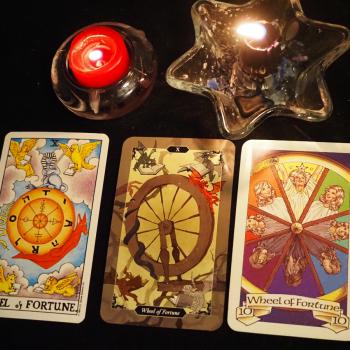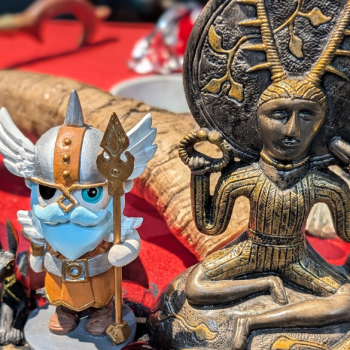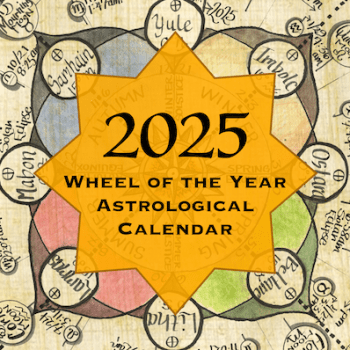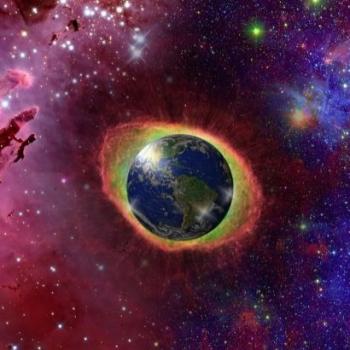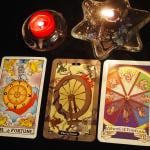[This is how my autobiography will begin. It took quite a while to realize that, rather than hiding the events of that, my own personal 9/11, that was the day I need to begin from. This is all very personal. I am taking inspiration from Star’s courage and honesty to tell the truth about myself. I don’t care whether it is what you want to hear.]
On the evening of Saturday, September 11th, 1976, I was attending a meeting—at Lydia’s home in the Richmond district of San Francisco—of the local council of the Covenant of the Goddess, the national church for Witches that I, my dear friends Tom DeLong (who wrote under his Craft name of Gwydion Pendderwen) and Alison Harlow, and a great many other people had created the year before. We were rather jazzed about COG. Seventeen covens of at least half a dozen different Traditions had signed the Covenant on June 21, 1975, bringing the church into existence, and had elected an interim board, with Alison as First Officer. A year later, the first official national board had been elected by the full procedures laid out in the charter and by-laws. At this meeting, we were electing the first official board for the local council; Lydia was chosen as its First Officer. Finally, the business completed, about a dozen people went home, leaving the rest of us to socialize.
I was still 35 that evening; I am now 70. It was exactly halfway through my life, so far. The story of how I became fascinated, then involved, with Witchcraft during the years from 1955 to 1976 needs to be very detailed. I will save that for later.
Because I had promised to help Dick and Judy move the next morning, I had decided before I left home to not take the first drink that evening. Long experimentation had proven to me that if I did not take the first drink, I could not get drunk. However, while my right hand was gesticulating punctuation of whatever we were discussing, my left hand reached out, seized the wine jug, and poured me that first drink. I never drank in bars; people start fights in bars. Lydia’s home seemed to me like a safe place to drink.
After a while people in twos and threes began disappearing into the bedrooms. I wanted intensely to join them, but I had not yet drunk enough to overwhelm my still very good-Catholic-boy inhibitions. We had invented a church that publicly avowed the sacredness of sexuality, but I could not bring myself to go into the bedroom by myself, and could not decide which woman friend to invite to come with me. Finally I took the hand of one of our priestesses and entered the master bedroom with her. As soon as I stepped into the dim room, a beautiful woman (now well-known as a writer), with a triumphant “Aha!”, grabbed me with both hands, helped me remove my clothing as rapidly as possible, and pulled me into a bed.
Later on Gwydion was teasing me, saying that only a true Irishman would insist on carrying the wine jug with us as we wandered from room to room, talking about . . . Goddesses? Magic? I cannot remember now.
Later still, an exquisite young woman gave herself to me. We made love; we walked about with my arm holding her close to me, talking with everyone; we went back into the bedroom and made love again. You see, I was an alpha male back then, not rich or powerful, true, but famous enough as a writer and ringleader in that faith community and immensely attractive to women, although one effect of my Catholic upbringing was that, even into my thirties, I could not grasp just how attractive I was. My wife, Melinda, has looked at photos of me from that era and says simply, “You were hot.”
Perhaps I glimpsed what rock stars experience with “groupies.” Melinda, who worked for ten years in the entertainment business in Hollywood, has told me of respectable middle-class women who did not hesitate to jump into bed with an actor or musician, then were bewildered afterward about what had come over them. That “what” was atavistic instincts, buried in each of us, that once helped guarantee the survival of our species.
A Puritan, ill-advisedly reading this, would by now be thinking, “Those Witches really do have orgies!” No, that’s not what they were—at least, the pejorative overtones of that term are completely inaccurate—but there is no established name for such events. “Dionysian” comes closer. They happened only spontaneously, by inspiration, never by planning. They happened when the energy of a group reached such a peak that it exploded into joyous celebration. And they happened rarely—I can remember only a half dozen such occurrences during the decade before that night—even though we all knew they were among the most extraordinary spiritual experiences we had ever had. Witches often refer to that phenomenon simply as “the Mystery.”
Puritans will also generally find it impossible to believe, let alone comprehend, how such an event could be spiritual at all, but the Witches I know do not believe that the flesh and the spirit are opposed, or that sex and religion are opposed. Many have come to the Craft movement specifically because they felt, as I did, that they had been abused by the community they grew up in. They too resented having been lied to, by being told that sex is evil, sinful, dangerous, immoral, and so on. Many of them instead believe now that sex is religious, that religion is inherently sexual. Those beliefs are in complete accord with the genuinely fundamental tenets of both Judaism and Christianity—but that is a topic I will explore later.
Many people these days do think it perfectly okay to have sex just for fun—if your mental health allows you to. The atmosphere of a swingers party is hedonistic and, as far as I have observed, guilt-free—but not spiritual at all. In contrast, the “Mystery” of the Witches is not pious, not reverent—it is far too wildly exuberant to be so serious—but afterward all who have partaken of it know they have been in touch with an aspect of divinity that most people never realize must exist.
So I do not regret the sacramental sexuality of that September evening. I cherish the memory of every woman whom I have been blessed and privileged to adore with my body, my mind, and my spirit. Even 35 years later I still have a tenuous but perceptible spiritual bond with that woman writer. I regret that I did not ask that other young woman her name. But what I deeply regret, the grievous sin I did commit, was that about 3:00 a.m. I drove six people, including Gwydion, home over the San Francisco Bay Bridge, in a car with no brakes, fading in and out of blackout. I don’t remember how I got us all home.
The next morning, sitting on a bench in Judy’s yard in San Anselmo, hung over, having had little sleep, listening to the bells of St. Anselm’s, thinking about the previous night, I realized that my decision to not take that first drink was still sitting there, rather like an IBM punch card behind my left ear. It had not been executed. I had not changed my mind, but I had gotten drunk anyway. Deciding to not take that drink no longer kept me from drinking. I had no control left over whether to drink or not. “My God,” I said, “I’m an alcoholic!” Then I wondered how I knew that.
I thought about the insanity of that drive home not many hours before. I must have a guardian angel who’s been doing double duty for me. I felt a presence to my right. Turning toward it, I saw my angel clearly, in my mind’s eye. He was tall, robed in white, had no wings, and was glaring at me. He said, in my mind, “All right, turkey. Now you know. You do that again, you’re on your own.” He slammed shut his attaché case and left. Having felt his presence, I now felt his absence. I was alone.
I got up, went to find Alta, told her what I had realized. She was not pleased. She had been trying to ignore the evidence. She knew that when I drank, I sometimes ended up in bed with another woman. She did not approve of that, but, being Italian, she understood it; she never threatened to divorce me over that. But she did not want to believe that she had married another alcoholic. She had gotten herself to Overeaters Anonymous a few months before, and she and my stepdaughter had often been discussing the Twelve Steps in my hearing. I was not consciously paying attention to their discussions, or perhaps I was unconsciously trying to ignore them. But I had heard; that is why I knew.
Because Alta had a copy of the A.A. Big Book, I was able to read through it before going to my first meeting. When I came to the Fifth Chapter, to the Twelve Steps, I thought, “This is how you do it!” I came to the Third Step: “Made a decision to turn our will and our lives over to the care of our Higher Power.” At that moment I made the decision to do that; I knew that was what I would need to do; but I had no idea how to do it. Turning my will over to God seemed about as impossible as picking myself up by the hair and holding myself out at arm’s length. Looking at the rest of the Steps, I thought, “Perhaps these are the process that enables you do that.” As I later learned, that was not a bad guess.
On the evening of September 12th, 1976, I attended my first A.A. meeting, at the Island Fellowship on Lincoln Avenue in Alameda, California. I had trepidations. I had no clear idea of what I might be facing. Perhaps I would have to swear allegiance to 39 incomprehensible articles of faith, paint myself blue, and dance on the tables. That made no difference. Whatever it was, I had to do it, because the alternative was to die. There’s an A.A. saying: “There’s nothing like the threat of death to make a man reasonable.” It was a great relief to discover that all I had to do was sit at a table, tell the truth about myself, and listen to others telling the truth about themselves. Not that discovering such truth is easy or simple.
Thus I added a daily A.A. meeting to my schedule of freelancing as a book editor and continuing with my doctoral program, now beginning its fourth year. I explained what I was now doing to all those in my life who deserved to know: Wayne Rood, my mentor and best friend at the Graduate Theological Union; Bruce Armbruster, since I was editing science texts and monographs for his new company; and Sarah.
“What happened to you?” she asked at Kirby Cove, where we were performing our annual commemoration of the Eleusinian Mysteries at the fall equinox.
“I got sober,” I told her.
She was more than disappointed. That was at least the third time I had walked away from her.
I also told Elaine Feigenbaum, the new Managing Editor whom the German owners of Scientific American had recently sent to take over the editing at W.H. Freeman and Company, its book-publishing subsidiary. She didn’t deserve to know, but I was being thorough.
So next I need to jump back to 1968, when I became an editor for Freeman.



